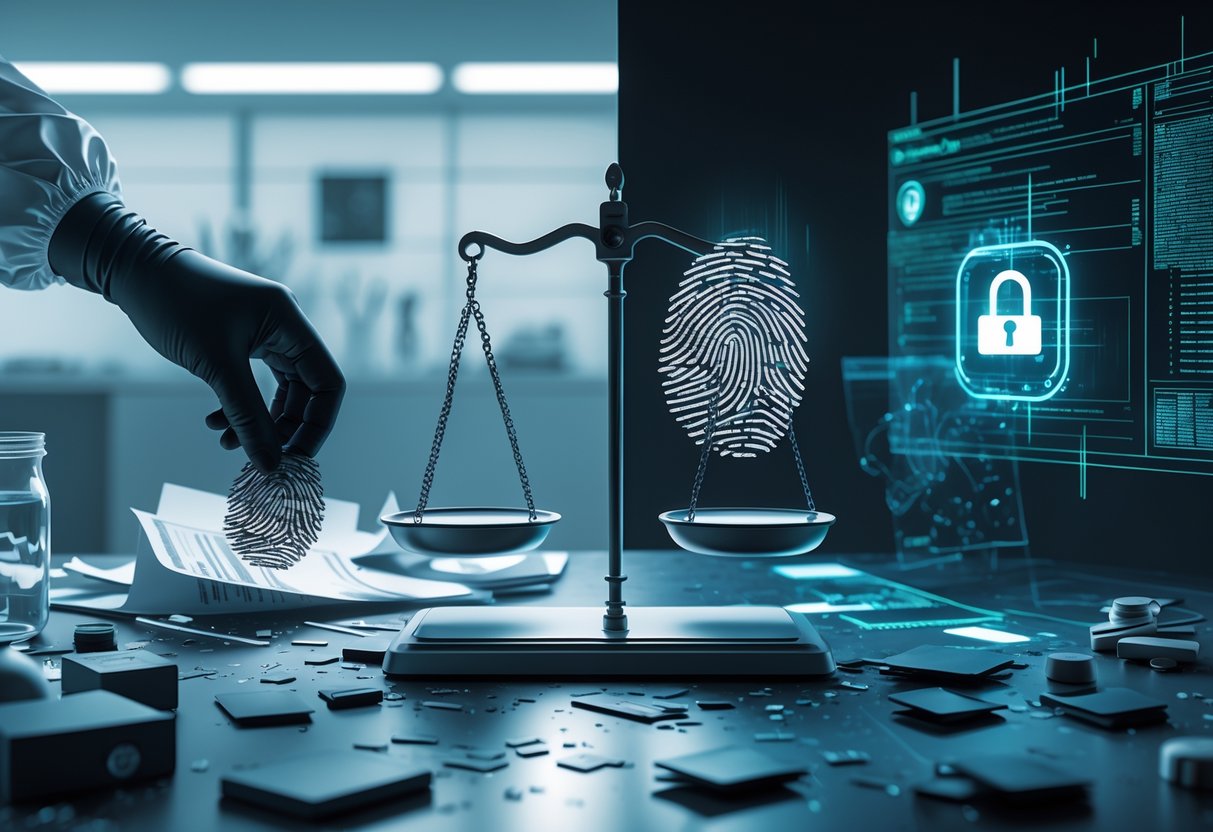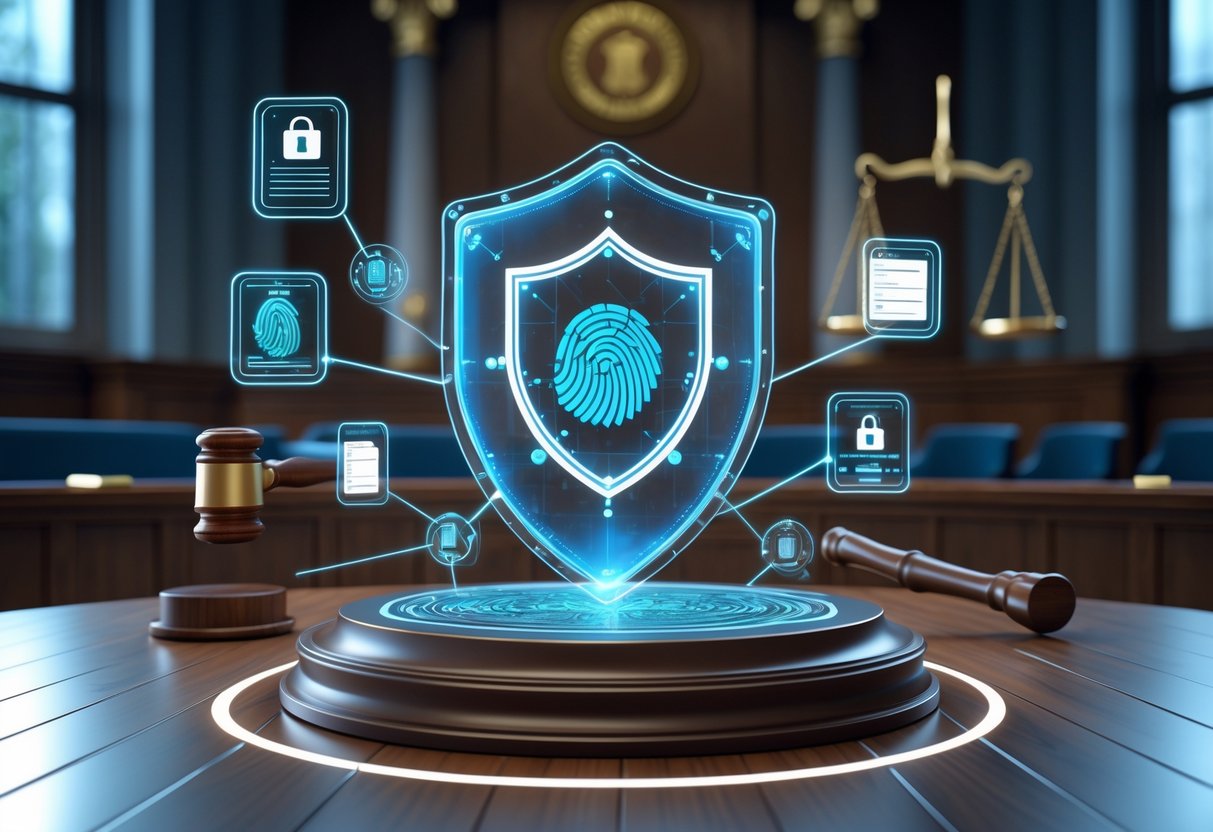Tampering Consequences: Legal Effects & Impact on Justice
Updated On: October 23, 2025 by Aaron Connolly
Understanding Tampering with Evidence
People tamper with evidence when they illegally alter, destroy, hide, or make up evidence to mess with legal cases. Investigators use tools like digital forensics or witness testimony to figure out if someone messed with physical or digital evidence.
Definition of Tampering
Tampering with evidence means someone purposely changes, destroys, hides, or creates fake evidence. The person has to mean for it to affect a legal investigation or trial.
This crime exists to keep the justice system honest. Judges and juries depend on real, reliable evidence to make decisions.
The law says there must be specific intent. Someone has to purposely mess with evidence, knowing it could influence a legal case. If someone ruins evidence by accident, that usually doesn’t count.
Key elements:
- Someone changed or destroyed evidence
- They wanted to interfere with justice
- There’s a link to an ongoing or soon-to-start investigation
People can tamper with evidence before, during, or after an investigation begins. Even if someone destroys evidence just because they think an investigation might happen, that can still count as a crime.
Types of Evidence Involved
Physical evidence can be documents, weapons, clothing, fingerprints, or DNA. Stuff you can see or touch often matters most in criminal cases.
People tamper with physical evidence by:
- Burning documents
- Washing blood off clothes
- Moving things at a crime scene
- Planting fake evidence
Digital evidence includes computer files, emails, texts, photos, and social media. Tech crimes almost always involve digital evidence tricks.
People tamper with digital evidence by:
- Deleting files
- Messing with document timestamps
- Editing images
- Making fake social media accounts
Courts treat digital and physical evidence tampering the same way. Both can get you in big trouble.
The justice system keeps changing to deal with new ways people try to destroy or hide evidence.
How Tampering is Detected
Digital forensics experts can bring back deleted files and spot changes. Hard drives hold onto data even after files get deleted, so it’s tough to erase everything.
Investigators use special programs to find:
- Deleted files and emails
- Changed timestamps
- Edited images
- Hidden or encrypted stuff
Witnesses sometimes see people getting rid of evidence. Maybe someone saw another person burning papers or moving something important at a crime scene.
Physical checks can show when something changed. Forensic teams look at ink, paper, fingerprints, or DNA to spot tampering.
Inconsistencies between stories and evidence make investigators suspicious. If what people say doesn’t match the evidence, police dig deeper.
Security cameras and phone records can also catch tampering in action. These tools help build a timeline of who did what and when.
Intent and Knowledge Requirements

Intent and knowledge sit at the heart of evidence tampering charges. Prosecutors have to show that someone knew what they were doing and meant to mess with or hide evidence.
Proving Deliberate Actions
Criminal intent means proving someone knowingly decided to change, destroy, or hide evidence. It’s not just a mistake.
Courts look for signs of purposeful behavior. Timing can say a lot—destroying evidence right after finding out about a police investigation usually shows intent. Hiding things in odd places or covering up the tampering also points to a deliberate act.
Prosecutors need to show the person knew their actions would mess with the evidence’s reliability or availability. For instance, deleting emails right before a hearing usually shows both knowledge and intent.
Digital evidence tampering happens more and more. Deleting files forever, messing with timestamps, or wiping hard drives takes some know-how, which can help prove intent.
Witnesses who notice odd or nervous behavior can help make the case. If someone says, “make sure no one finds this,” that’s pretty telling.
Role of Mistakes and Accidents
Accidental handling of evidence isn’t tampering, even if it ruins something important. The difference is all about what the person knew and meant to do.
Accidents might be regular document shredding without knowing about a case, a computer crash, or losing something during normal work.
Just being careless usually won’t get you charged with tampering. But you could still face civil or job consequences. That difference really matters for punishment.
Defense attorneys often argue there was no intent. If someone followed normal routines, didn’t know about an investigation, or honestly thought what they did was fine, they can beat tampering charges.
Prosecutors have to prove both intent and knowledge beyond reasonable doubt. If the evidence points to a mistake, criminal charges often fall apart or get reduced.
Legal Consequences Under UK and Federal Law

Tampering penalties depend on where you are and how serious the case is. In the US, most tampering cases become federal crimes and can mean up to 10 years in prison. UK law splits tampering into summary offences or indictable crimes, and the punishment changes based on the details.
Felony vs. Misdemeanour Charges
Federal law usually treats tampering as a felony. Messing with mail is a federal crime under the US Postal Service. The justice system handles these in federal court, often with minimum sentences.
If you mess with government records, you’ll likely face felony charges. Tampering during a court case bumps up the punishment.
In the UK, tampering falls into several categories:
- Summary offences: Minor cases, handled in magistrates’ courts
- Indictable offences: Serious cases, sent to Crown Court
- Either-way offences: In-between, and the prosecution picks the court
The type of document and the harm intended decide the category. Legal and financial documents usually mean harsher treatment than personal letters.
Potential Sentences and Fines
US federal convictions for tampering come with tough penalties:
| Offence Type | Prison Sentence | Maximum Fine |
|---|---|---|
| Mail tampering | Up to 5 years | £250,000 |
| Evidence tampering | Up to 10 years | £500,000 |
| Document fraud | Up to 20 years | £1 million |
In the UK, magistrates’ courts can give up to 6 months in jail and £5,000 in fines. Crown Courts take on the worst cases, with unlimited fines and up to 10 years behind bars.
Heads up: Federal convictions stick with you and can mess up your job and travel plans. In the UK, these convictions show up on enhanced DBS checks, making it tough to get certain jobs.
Repeat offenders get even harsher sentences. The justice system sees tampering as a betrayal of public trust, so penalties are strict.
Criminal Investigations and Evidence Tampering
Evidence tampering makes it way harder for police to solve crimes and get convictions. When someone destroys or changes evidence, investigations can fall apart and guilty people might walk free.
Impact on Police Investigations
Tampering throws up big obstacles for police. When suspects get rid of physical evidence, officers lose key clues.
Common problems for investigations:
- Missing fingerprints or DNA
- Destroyed documents or files
- Changed crime scenes
- Hidden weapons or drugs
Police have to work extra hard to build cases without the best evidence. They might need to hunt for other proof or more witnesses. That eats up time and money.
Digital evidence is tricky. Suspects can delete files, wipe phones, or smash hard drives. Now, police need computer experts just to try to recover what’s lost.
Sometimes, tampering happens right in the middle of an investigation. If a suspect swallows drug evidence during a raid, police have to rely on what people saw instead of lab tests.
Timing really counts. If someone destroys evidence before police even start looking, it might not be tampering. The law says you have to know an investigation is coming.
Influence on Case Outcomes
Tampering can make or break a court case. Prosecutors need solid evidence to prove someone’s guilty.
What happens when evidence goes missing:
- Prosecutors might settle for plea deals
- Charges could get dropped or lowered
- Guilty verdicts get a lot harder to win
- Convictions might get overturned on appeal
Funny enough, tampering can backfire. Destroying evidence is its own crime, so prosecutors get another shot at charging someone.
Juries don’t like it when evidence disappears. They often think the missing stuff would have shown guilt—this is called “adverse inference.”
Federal cases hit harder. Tampering in federal investigations can mean up to 20 years in prison. State penalties can still be pretty rough, with big fines and jail time.
The justice system needs honest evidence to work. When people mess with it, public trust takes a hit and police have a tougher job.
Evidence Tampering in Court Proceedings

Evidence tampering can throw criminal cases into chaos for both sides. Prosecutors might lose their main proof, and defendants can get slapped with even worse charges for hiding or destroying evidence.
Effects on Prosecutions
When someone tampers with evidence, prosecutors lose key parts of their case. If documents go missing or get changed, proving guilt gets way tougher.
Courts usually toss out evidence that’s been tampered with. Even if some parts are fine, they can’t use it at trial.
Big problems for prosecutors:
- Cases get weaker without physical evidence
- Harder to prove the crime even happened
- Need to rebuild cases from scratch
- Delays while police look into the tampering
Sometimes, prosecutors just drop charges if too much evidence is gone. Other times, they’ll offer plea deals for lesser crimes to avoid losing in court.
The prosecution has to prove tampering was on purpose. They need to show the defendant knew about the investigation and destroyed evidence anyway.
Implications for Defendants
Tampering charges can be even worse than the original crime. Federal tampering can mean up to 20 years in prison.
A lot of states treat tampering as a felony. In Texas, for example, it’s a third-degree felony, with 2-10 years in prison and up to £7,800 in fines.
A defense attorney might use several strategies:
| Defence Strategy | Approach | Example |
|---|---|---|
| Lack of intent | Say it was an accident | Cleaning up, not knowing evidence was there |
| No knowledge | Didn’t know about the investigation | Destroyed stuff before police got involved |
| Duress | Forced to do it | Co-defendant made threats |
Defendants also face fallout beyond jail or fines. Judges see tampering as an attack on the entire justice system.
If tampering happens alongside another crime, judges usually give tougher sentences. Prior convictions for similar stuff can mean the maximum penalty.
Often, the tampering charge ends up being the biggest problem—even if the original crime was minor.
Physical Versus Digital Evidence Tampering

Physical and digital evidence both face tampering risks, but the details and challenges aren’t the same. People usually destroy or contaminate physical evidence, while digital evidence can get manipulated without leaving any obvious clues.
Common Forms of Physical Evidence Tampering
Physical evidence tampering can take many forms, and it can really wreck a case. Destroying evidence is probably the most common tactic.
Suspects sometimes burn documents, toss weapons in rivers, or wash clothes to erase DNA. Investigators usually spot these gaps pretty quickly.
Contamination is another headache. When too many people handle evidence without gloves or care, fingerprints get mixed up. Blood samples can turn useless if stored the wrong way.
Planting fake evidence happens too. Someone might leave items at a crime scene just to send investigators in the wrong direction.
Main tampering tricks include:
- Burning or shredding documents
- Cleaning surfaces to erase traces
- Moving items from their original spots
- Adding foreign stuff to samples
- Breaking or damaging physical evidence
One thing about physical evidence—it often betrays the tampering. Torn papers, leftover cleaning chemicals, or missing items set off alarms for investigators.
Risks of Digital Evidence Manipulation
Digital evidence comes with its own set of tampering problems, and honestly, it’s a lot sneakier. People can change files without leaving much of a trace.
Changing timestamps is pretty common. Someone might alter when an email was sent or a photo was taken, which can totally mess with the timeline.
Editing metadata is another trick. Folks can quietly change where a photo was taken, who wrote a document, or when it was made.
Selective deletion is a big issue too. People delete just the right messages or files, leaving everything else untouched. Investigators end up with an incomplete story.
Common digital tampering looks like:
- Changing file dates and times
- Editing documents after they’re created
- Deleting certain emails or messages
- Faking photo locations through metadata
- Making up digital conversations
Digital evidence really needs special forensic tools. Experts rely on hash values, backups, and digging into metadata to catch sneaky edits that regular people would never notice.
The hardest part with digital stuff? Proving it’s real. Physical evidence leaves marks if you mess with it, but digital files can be copied and tweaked so perfectly, nobody can tell.
Destroying and Concealing Evidence
Destroying evidence means you get rid of physical stuff or digital files that could come up in a legal investigation. Concealing evidence is all about hiding things so nobody finds them or uses them in court.
Shredding Documents
People often shred documents to destroy physical evidence and avoid prosecution. This covers contracts, financial records, printed emails, and handwritten notes.
Courts take document destruction seriously. If you shred papers knowing they might be evidence, you could get hit with tampering charges—even if nobody’s started investigating yet.
Some common examples:
- Financial records showing shady deals
- Business contracts that prove misconduct
- Personal notes that could get someone in trouble
- Medical records that might matter in a case
Intent matters here. If you destroy papers by accident, you probably won’t face tampering charges.
Eliminating Electronic Files
People destroy digital evidence by deleting files, wiping hard drives, or smashing devices. This covers emails, texts, photos, videos, and digital docs.
A lot of folks think deleted files are gone forever. Digital forensics experts can often recover them from hard drives or phones.
Examples of digital tampering:
- Deleting incriminating emails or texts
- Wiping computers clean
- Destroying phones or tablets
- Removing files from cloud accounts
Timing is huge. Deleting stuff after you’ve been told to keep it brings much tougher penalties than just clearing files before any investigation.
Heads up: Even files you think are “permanently deleted” can often be dug up by specialists. Destroying digital evidence is risky.
Law Enforcement and Institutional Tampering
When law enforcement or government officials tamper with evidence, the fallout spreads through the whole justice system. These cases can bring federal charges, lead to wrongful convictions, get cases thrown out, and just wreck public trust.
Police Evidence Tampering
Police who tamper with evidence risk serious federal crime charges. The most common are obstruction of justice under 18 U.S.C. § 1503 and witness tampering under 18 U.S.C. § 1512.
Officers can tamper in a bunch of ways:
- Planting drugs or weapons at scenes
- Destroying DNA or fingerprints
- Faking police reports or witness statements
- Hiding evidence that could clear someone
The fallout is brutal. Officers can get 10 to 20 years in federal prison depending on how bad it is. They lose their law enforcement license for good.
Federal investigations often follow these cases. The FBI usually steps in when civil rights are violated.
Official Misconduct and Consequences
Government officials who mess with records or evidence face big legal trouble. Federal prosecutors use 18 U.S.C. § 1505 to go after officials who block administrative proceedings.
Common types of official tampering:
| Type | Examples | Penalties |
|---|---|---|
| Document alteration | Changing dates, signatures, or details | 5-20 years prison |
| Record destruction | Deleting files, shredding papers | 10-20 years prison |
| False certification | Signing fake documents | 5-15 years prison |
The justice system comes down hard on these cases because officials are supposed to be trustworthy. Judges often give out the maximum sentences to keep public faith intact.
Officials can get sued by victims in federal court. Many lose their pensions and have their professional licenses yanked.
Federal prosecutors sometimes add conspiracy charges if more than one official is involved, which can tack on extra prison time.
Role of a Criminal Defence Solicitor

A criminal defence solicitor steps in as your best shot when you’re facing tampering charges. They’ll fight weak evidence and build a defence to protect your rights in court.
Building a Defence Against Tampering Charges
Your solicitor digs into every detail of the tampering accusations. They look for weak spots in the prosecution’s story and collect evidence that backs you up.
Common defence tactics:
- Challenging the chain of custody
- Showing you didn’t mean to tamper
- Proving you didn’t know about the evidence
- Pointing out there’s not enough proof
Your solicitor talks to witnesses who can help your case. They’ll also bring in experts who might explain why evidence just looks tampered with, even if it’s not.
The attorney gets legal arguments ready before court. They know which laws matter and how to use them in your favor.
Your legal team also negotiates with prosecutors. Sometimes they can get charges reduced or dropped before you even get to trial.
Assessing Evidence Integrity
Your solicitor checks all the evidence the prosecution plans to use. They make sure police collected and stored it the right way.
Things they look at:
- How evidence came from the scene
- Who touched the evidence before trial
- If storage rules were followed
- Whether testing was done right
They’ll call in forensic experts if needed. These specialists can show the evidence wasn’t really tampered with, or that it was handled poorly.
Your team also reviews digital evidence like emails or computer files. They check if something could have changed by accident or through normal computer use.
In court, your solicitor challenges anything that seems shaky. They ask tough questions about how evidence was handled and whether it actually proves tampering.
Victims and Wider Impact on the Justice System

Evidence tampering doesn’t just hurt one case—it sends shockwaves through the whole system. When someone messes with evidence, innocent people can get convicted and the guilty can walk free. It undermines investigations and erodes public faith in the legal process.
Wrongful Convictions
Tampering often leads directly to wrongful convictions. Fake or altered evidence can put investigators on the wrong track. The National Registry of Exonerations has counted over 3,000 wrongful convictions in the US, and a lot of those cases involve some kind of evidence manipulation.
Criminal investigations depend on physical evidence, witness statements, and forensics. If someone tampers with any of these, the whole case can fall apart. Innocent people might get convicted because of fake DNA, planted weapons, or forced witness statements.
The fallout is devastating. Wrongfully convicted people lose years behind bars while the real criminals stay free. The system struggles to fix these mistakes, and it can take decades to set things right.
Main tampering factors:
- Messing with crime scene evidence
- Faking forensic test results
- Pressuring witnesses to lie
- Destroying evidence that could clear someone
Erosion of Public Trust
When tampering comes out, it shakes public trust in the justice system. People start wondering if investigations are fair or if court verdicts mean anything. That kind of doubt makes it harder for law enforcement to do their job.
The justice system really needs the public’s trust. Witnesses have to come forward, juries need to believe the evidence, and communities must work with police. Tampering scandals damage all of this.
Media coverage of these cases often exposes bigger problems in police departments or labs. Once people see a pattern, trust takes a major hit. Public scepticism grows even more when several cases pop up in the same area or involve the same officials.
Signs of lost trust:
- Less cooperation with police
- Juries doubting prosecution evidence
- Fewer crime reports from victims
- More pressure for justice system reforms
Defences Against Evidence Tampering Accusations

If you’re facing evidence tampering charges, there are still strong defence strategies out there. The best defences usually focus on showing you didn’t mean to tamper or poking holes in the prosecution’s case.
Lack of Intent
Showing you didn’t have intent is a key defence. The prosecution has to prove you knowingly and deliberately changed, destroyed, or hid evidence.
If you can show your actions were accidental, the charges might not hold up. Accidentally deleting files or not realizing you were handling evidence isn’t tampering.
A good attorney will check if you even knew about any legal proceedings. If you weren’t aware, the intent element just isn’t there.
Top intent defences:
- Didn’t know about the investigation
- Accidentally destroyed or changed evidence
- Believed you were acting in good faith
- No deliberate deception
Prosecutors have to prove intent beyond a reasonable doubt. If they can’t, the case can fall apart.
Challenging the Prosecution’s Evidence
You can also attack the prosecution’s evidence and how they got it. This strategy is all about creating reasonable doubt.
Your defence team will dig into how investigators collected evidence. If your rights got trampled during searches or questioning, that evidence might get thrown out.
Common ways to challenge:
- Not enough evidence linking you to tampering
- Investigators breaking rules
- Unreliable witnesses
- Timeline problems
Sometimes, what looks like tampering has a simple explanation. Expert witnesses can help by explaining technical stuff or offering a different take—especially when digital evidence is involved.
Frequently Asked Questions

Product tampering brings tough legal penalties and can totally tank consumer trust in a brand. Companies might face criminal charges and lawsuits, while consumers definitely need to know how to protect themselves.
What are the potential penalties for product tampering?
Product tampering usually leads to felony convictions, and the consequences are tough. Courts often hand out prison sentences that can last from several months to many years, depending on how serious the tampering was and what the intent looked like.
Fines for individuals can hit tens of thousands of pounds. If a business gets caught, the financial penalties can soar past £100,000.
A conviction sticks around on your criminal record for good, making it tough to find future jobs. If you work in a regulated field, you might lose your professional licence, or at least face a suspension.
Civil liability brings even more risk. Victims may sue for compensation to cover medical bills, lost income, and the stress or trauma they suffered.
How can consumer trust be rebuilt after a tampering incident?
Rebuilding trust starts with being open about the incident. Companies need to admit what happened and not try to dodge responsibility.
Taking quick action matters. Voluntary recalls, tighter security, and better quality control all signal that the company cares about safety.
Keeping customers updated helps keep some credibility intact. People want to see real changes, not just empty promises.
Independent safety audits can back up claims about new security steps. When a third party checks things out, it just feels more reliable.
Offering compensation to affected customers shows the company is taking things seriously. This could mean refunds, help with medical bills, or other support.
What steps should one take if they suspect product tampering?
If you suspect tampering, stop using the product right away and keep it as evidence. Hold on to the packaging and anything that looks contaminated, since investigators may need it.
Reach out to local police or trading standards authorities to report the incident. Many places have special units for consumer protection and tampering cases.
If you’ve used or eaten the product, see a doctor as soon as possible. Make sure to document any symptoms or reactions with a healthcare professional.
Take photos of the product and packaging from different angles before anyone else handles them. These pictures can help investigators figure out what happened.
Get in touch with the manufacturer’s customer service to let them know about the issue. Many companies run safety hotlines for reports like this.
Keep a record of every conversation, medical visit, and expense related to the incident. If you end up taking legal action, this information will be important.
Are there any specific laws governing the manipulation of food products?
Food safety laws crack down hard on tampering with anything meant for consumption. The Food Safety Act and similar rules make it illegal to sell food that’s been purposely contaminated or changed.
If someone tampers with food in a way that puts lives at risk, courts can give out sentences as long as 21 years. Even less serious cases can still bring big criminal penalties.
Regulators have a lot of authority to investigate food tampering. Trading standards officers can take away products, inspect businesses, and press charges.
Businesses that ignore food safety rules can face unlimited fines. They might also lose their licence to run a food business.
If a product is contaminated, the law requires manufacturers to pull it from shelves right away. Ignoring this rule brings even more criminal and civil penalties.
How does tampering impact the reputation of a brand?
Tampering hits a brand’s reputation hard and fast. Customers usually lose confidence, and sales drop—sometimes for a long time.
The media takes incidents like this and spreads them quickly. News stories and social media posts can reach millions before the company even has a chance to respond.
If the company is publicly traded, stock prices often fall. Investors start doubting whether management can keep products safe or maintain quality.
Some brands never really bounce back to where they were before the incident. Regaining market share and trust can take years, if it happens at all.
Competitors often benefit, since customers might switch to other brands. That loss in market position can stick around long after the tampering is old news.
What safety measures can companies implement to prevent tampering?
Tamper-evident packaging stands as the first line of defense against product manipulation. Seals, shrink wraps, and breakaway caps let consumers spot unauthorized access right away.
Companies track products from manufacturing to retail sale using supply chain security measures. They rely on secure transportation, controlled access facilities, and trusted distributor networks.
Teams run regular quality control inspections to catch potential tampering at different stages. They use random sampling and testing to spot contamination before products ever reach the shelves.
Managers conduct employee background checks and offer security training to cut down on internal tampering risks. Staff need clear protocols for reporting anything suspicious or any security breach.
Surveillance systems keep an eye on production and storage areas around the clock. CCTV cameras and access controls record exactly who handles products and when.
Customer reporting systems make it easy for people to flag suspected tampering. Hotlines and online portals give consumers a quick way to raise safety concerns.

